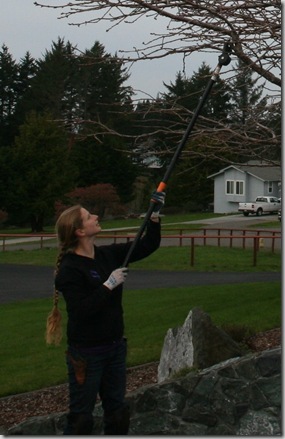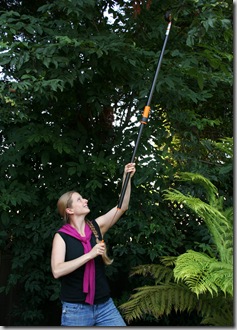Anne Asher, a movement specialist from The MOVE! Blog, answers questions about how professional or passionate gardeners can reduce the strain that comes from repetitive gardening tasks. Check out her new product – great for winter time – called Clear the Blear. Here’s this month’s installment: When pruning apple and other trees in January, I often tire my shoulders using the pole pruners or sawing/ pruning above my head. Have you got any tips for easing shoulder pain while pruning trees? Hi Gen, The first thing that comes to mind is that you probably are not “in tune” with your shoulder blades, those flat triangular shaped bones located on your upper back. Those bones are there for a reason. When you don’t involve them in the work you do, your arms must provide all the power for the pruning. This takes a LOT of muscle, and after a while they get so tired and sore they go on strike! And you can feel that.  As you become aware of the natural ability of the shoulder blades to support the upper back, you will probably be able keep the tension out of the tops of the shoulders while you work. Try taking one hand and wrapping it around your ribs until you can touch the shoulder blade in the back. Got that? Now lift the arm (the one that’s attached to the shoulder blade you are touching) and move it in various directions. Once you can sense the ability of the shoulder blade to move, then try moving just the shoulder blade. Try squeezing it toward your spine. Feel the shoulder blade as is slides across the ribcage. Congratulations! You’ve isolated the action of the shoulder blade. Next, try inhaling and moving them up to your ears and hold them there. Exhale and drop them. Try again – inhale, bring them up and squeeze. Exhale and release. The idea here is that you want to not only be aware of the shoulder blades, but also strengthen the muscles that move them. These simple exercises are great for that, but you can also work with free weights and gym machines. The yoga down dog, done correctly will help you with shoulder flexibility and strength, so that’s another good one. Another thing you could do to condition this area are wall push ups. Just stand a foot or two away from the wall. Lean your whole body in when you do this exercise – be like a plank – don’t bend your spine or break at the hips. The hands on the wall should be at about the nipple level. Then push against the wall and come up. All of these exercises get you prepared for taking the load in your shoulders, and not your arms. Also, it’s important to keep your “core” strong. So doing things like Pilates and yoga will help you separate the use of your arms from the use of your shoulders, and the use of your shoulders from the use of your arms. Once you can do that, you have choices as to how to go about pruning those trees! ***Do you have any areas that hurt you when you garden? Let us know in the comments, and Anne can answer your questions in future articles.*** Anne Asher has been in the bodywork and holistic health field for over 20 years. She has worked in chiropractors’ offices, physical therapy clinics and in her own business. She taught Pilates based exercise to people with chronic musculoskeletal pain for 5 years in Humboldt County. Anne is now the Back and Neck Pain guide on About.com. About.com is a New York Times web property. If you like this post, you may also enjoy: Your Gardening Body: Digging Without Strain or Pain Your Gardening Body: Using Loppers Safely Without Strain or Pain Your Gardening Body: How to Rake and Sweep Without Strain or Pain
As you become aware of the natural ability of the shoulder blades to support the upper back, you will probably be able keep the tension out of the tops of the shoulders while you work. Try taking one hand and wrapping it around your ribs until you can touch the shoulder blade in the back. Got that? Now lift the arm (the one that’s attached to the shoulder blade you are touching) and move it in various directions. Once you can sense the ability of the shoulder blade to move, then try moving just the shoulder blade. Try squeezing it toward your spine. Feel the shoulder blade as is slides across the ribcage. Congratulations! You’ve isolated the action of the shoulder blade. Next, try inhaling and moving them up to your ears and hold them there. Exhale and drop them. Try again – inhale, bring them up and squeeze. Exhale and release. The idea here is that you want to not only be aware of the shoulder blades, but also strengthen the muscles that move them. These simple exercises are great for that, but you can also work with free weights and gym machines. The yoga down dog, done correctly will help you with shoulder flexibility and strength, so that’s another good one. Another thing you could do to condition this area are wall push ups. Just stand a foot or two away from the wall. Lean your whole body in when you do this exercise – be like a plank – don’t bend your spine or break at the hips. The hands on the wall should be at about the nipple level. Then push against the wall and come up. All of these exercises get you prepared for taking the load in your shoulders, and not your arms. Also, it’s important to keep your “core” strong. So doing things like Pilates and yoga will help you separate the use of your arms from the use of your shoulders, and the use of your shoulders from the use of your arms. Once you can do that, you have choices as to how to go about pruning those trees! ***Do you have any areas that hurt you when you garden? Let us know in the comments, and Anne can answer your questions in future articles.*** Anne Asher has been in the bodywork and holistic health field for over 20 years. She has worked in chiropractors’ offices, physical therapy clinics and in her own business. She taught Pilates based exercise to people with chronic musculoskeletal pain for 5 years in Humboldt County. Anne is now the Back and Neck Pain guide on About.com. About.com is a New York Times web property. If you like this post, you may also enjoy: Your Gardening Body: Digging Without Strain or Pain Your Gardening Body: Using Loppers Safely Without Strain or Pain Your Gardening Body: How to Rake and Sweep Without Strain or Pain
Your Gardening Body: How to Prune Trees Without Strain or Pain

2 responses to “Your Gardening Body: How to Prune Trees Without Strain or Pain”
I have recently encountered terrible pain in my hands from pruning. I know I have some arthritis but this has been an unusual type of pain. I have gardened for 25 years with not pain from pruning. Do you have thoughts and/or suggestions. Oh, I use good Felco pruners.
Hi Ellen,
I would love to help, but this doesn’t sound like a normal case of strain and pain. I’d see your doctor or chiropractor and see what they have to say. Good luck!